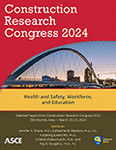Facilitators and Barriers to the Adoption of Active Back-Support Exoskeletons in the Construction Industry
Publication: Construction Research Congress 2024
ABSTRACT
The construction industry is known for the prevalence of musculoskeletal disorders, particularly back disorders, which are triggered by work involving abnormal postures. Active back-support exoskeletons are increasingly being perceived as ergonomic interventions to reduce the risks associated with construction work. This study examined the factors that would influence the adoption of active back-support exoskeletons in the construction industry. Using the Delphi approach, two-round surveys were conducted with key stakeholders such as safety professionals, supervisors, site superintendents, and construction professionals. The participants had the opportunity to experience the exoskeleton and provide feedback on the factors that could influence the adoption of the technology. The findings reveal the most important facilitators and barriers that should be considered to enhance the adoption of active back-support exoskeletons in the construction industry. The results could provide a practical guide for construction organizations to understand the requirements for implementing exoskeletons in their organizations. Manufacturers could use the design-related facilitators and barriers to adapt exoskeleton designs to construction work.
Get full access to this article
View all available purchase options and get full access to this chapter.
REFERENCES
Alomari, K. A., J. A. Gambatese, and N. Tymvios. (2018). “Risk Perception Comparison among Construction Safety Professionals: Delphi Perspective.” Journal of Construction Engineering and Management 144(12). https://doi.org/10.1061/(ASCE)CO.1943-7862.0001565.
BLS. (2020). “Injury and illness rate per 10,000 full-time workers.” Retrieved April 28, 2023, from https://data.bls.gov/pdq/SurveyOutputServlet.
Cha, J. S., S. Monfared, D. Stefanidis, M. A. Nussbaum, and D. Yu. (2020). “Supporting surgical teams: Identifying needs and barriers for exoskeleton implementation in the operating room.” Human Factors 62(3): 377–390. https://doi.org/10.1177/0018720819879271.
Chinedu, O. O., A. T. Henry, J. J. Nene, and J. D. Okwudili. (2020). “Work-related musculoskeletal disorders among office workers in higher education institutions: A cross-sectional study.” Ethiopian Journal of Health Sciences 30(5). doi:https://doi.org/10.4314/ejhs.v30i5.10.
Elprama, S. A., B. Vanderborght, and A. Jacobs. (2022). “An industrial exoskeleton user acceptance framework based on a literature review of empirical studies.” Applied Ergonomics 100: 103615. https://doi.org/10.1016/j.apergo.2021.103615.
Hallowell, M. R., and J. A. Gambatese. (2010). “Qualitative research: Application of the Delphi method to CEM research.” Journal of construction engineering and management 136(1): 99–107. https://doi.org/10.1061/ASCECO.1943-7862.0000137.
Hu, Y., A. P. C. Chan, and Y. Le. (2015). “Understanding the Determinants of Program Organization for Construction Megaproject Success: Case Study of the Shanghai Expo Construction.” Journal of Management in Engineering 31(5). https://doi.org/10.1061/(ASCE)ME.1943-5479.0000310.
Karakhan, A. A., J. A. Gambatese, D. R. Simmons, and A. J. Al-Bayati. (2021). “Identifying pertinent indicators for assessing and fostering diversity, equity, and inclusion of the construction workforce.” Journal of management in engineering 37(2): 04020114. https://doi.org/10.1061/(ASCE)ME.1943-5479.0000885.
Kim, S., A. Moore, D. Srinivasan, A. Akanmu, A. Barr, C. Harris-Adamson, D. M. Rempel, and M. A. Nussbaum. (2019). “Potential of exoskeleton technologies to enhance safety, health, and performance in construction: Industry perspectives and future research directions.” IISE Transactions on Occupational Ergonomics and Human Factors 7(3-4): 185–191. https://doi.org/10.1080/24725838.2018.1561557.
Nnaji, C., I. Okpala, J. Gambatese, and Z. Jin. (2023). “Controlling safety and health challenges intrinsic in exoskeleton use in construction.” Safety Science 157. https://doi.org/10.1016/j.ssci.2022.105943.
Okpala, I., C. Nnaji, and J. Gambatese. (2023). “Assessment Tool for Human–Robot Interaction Safety Risks during Construction Operations.” Journal of Construction Engineering and Management 149(1). https://doi.org/10.1061/(ASCE)CO.1943-7862.0002432.
Otten, B. M., R. Weidner, and A. Argubi-Wollesen. (2018). “Evaluation of a Novel Active Exoskeleton for Tasks at or Above Head Level.” IEEE Robotics and Automation Letters 3(3): 2408–2415.
Poliero, T., V. Fanti, M. Sposito, D. G. Caldwell, and C. D. Natali. (2022). “Active and Passive Back-Support Exoskeletons: A Comparison in Static and Dynamic Tasks.” IEEE Robotics and Automation Letters 7(3): 8463–8470. https:.doi.org/10.1109/BIOROB52689.2022.9925372.
Rajendran, S., and J. A. Gambatese. (2009). “Development and initial validation of sustainable construction safety and health rating system.” Journal of construction engineering and management 135(10): 1067–1075. https://doi.org/10.1016/j.ergon.2021.10310310.1061/ASCE0733-93642009135:101067.
Schwerha, D. J., N. McNamara, M. A. Nussbaum, and S. Kim. (2021). “Adoption potential of occupational exoskeletons in diverse enterprises engaged in manufacturing tasks.” International Journal of Industrial Ergonomics 82: 103103. https://doi.org/10.1016/j.ergon.2021.103103.
Upasani, S., R. Franco, K. Niewolny, and D. Srinivasan. (2019). “The potential for exoskeletons to improve health and safety in agriculture—Perspectives from service providers.” IISE Transactions on Occupational Ergonomics and Human Factors 7(3-4): 222–229. https://doi.org/10.1080/24725838.2019.1575930.
Yeoh, W., J. Gao, and A. Koronios. (2008). Towards a critical success factor framework for implementing business intelligence systems: A Delphi study in engineering asset management organizations. Research and Practical Issues of Enterprise Information Systems II: Volume 2 IFIP TC 8 WG 8.9 International Conference on Research and Practical Issues of Enterprise Information Systems (CONFENIS 2007) October 14–16, 2007, Beijing, China, Springer. https://doi.org/10.1007/978-0-387-76312-5_64.
Information & Authors
Information
Published In
History
Published online: Mar 18, 2024
ASCE Technical Topics:
- Building design
- Buildings
- Business management
- Construction engineering
- Construction industry
- Construction management
- Construction sites
- Design (by type)
- Engineering fundamentals
- Facilities (by type)
- Industrial facilities
- Organizations
- Personnel management
- Practice and Profession
- Structural engineering
- Structures (by type)
Authors
Metrics & Citations
Metrics
Citations
Download citation
If you have the appropriate software installed, you can download article citation data to the citation manager of your choice. Simply select your manager software from the list below and click Download.
